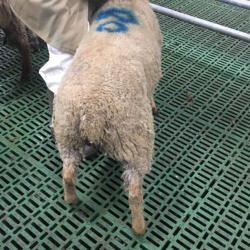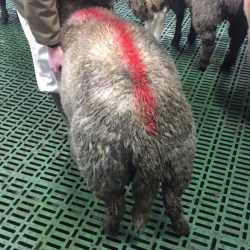With ground conditions getting soft and heavy, and rainfall becoming more frequent, the issue of lambs becoming dirty is, and will continue to be, a problem over the coming months.
This issue is likely to arise when lambs are housed in sheds.
Sheep that have dirty/soiled fleeces are in danger of not meeting the Clean Livestock Policy (CLP) regulations that were implemented in 2016 by the Department of Agriculture, Food and the Marine.
Some factories are sending warnings out about dirty sheep, with one factory going as far as to say that sheep that are presented dirty will be “sent home” and advising to “dag any dirty tail ends” before sending them to the factory.
Clean Livestock Policy
The CLP for sheep was introduced in 2016 and it’s a three-category system. Under the policy, sheep are classified as being satisfactory (Category A), acceptable (Category B) or unacceptable (Category C).
It was introduced to “significantly improve performance in relation to the cleanliness of incoming sheep” to DAFM-approved slaughter plants.
Category A
- These are sheep with a clean and dry fleece that can be slaughtered without an unacceptable risk of contaminating the meat during the slaughter process, by using the standard hygienic dressing procedure routinely employed by the plant.
Category B
- Sheep in this category are classified as having a moderate soiling of fleece that can only be slaughtered, without an acceptable risk of contamination of the meat during the slaughter process, by putting in place additional interventions. This includes extra defined dressing controls.
Category C
- These are sheep with a heavily contaminated fleece unfit for slaughter. These sheep must not be presented for ante-mortem in this condition and it is the responsibility of the food business operator to take the required remedial action.
What can farmers do?
To help reduce the risk of sheep falling into the latter category – Category C – the DAFM offers farmers the following advice:
- Tail dock lambs in the first seven days of life;
- Implement a control programme to reduce scouring;
- Avoid sudden changes in the diet;
- Crutch/dag lambs before turning them onto crops;
- Move finishing lambs to clean pasture when conditions become muddy;
- Move feeders regularly to avoid poaching;
- In straw-bedded sheds, use adequate straw and replenish regularly;
- In slatted sheds, ensure they do not get blocked;
- Do not overstock pens in sheds;
- Poor transport conditions may result in animals becoming contaminated and failing to achieve required cleanliness specification. Vehicles should be roofed (where possible) and well ventilated;
- Ensure the vehicle is clean; dry; and disinfected before loading;
- Only clean sheep should be sent to the slaughter plant.
In the gallery below, more examples of Category A, B and C sheep are displayed.
Click on a thumbnail in the gallery to open up a full-size image; once opened you can scroll sideways to see the next picture.









